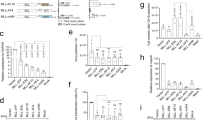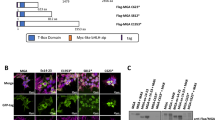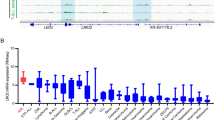Abstract
Although oncogenic functions and the clinical significance of Wilms tumor 1 (WT1) have been extensively studied in acute leukemia, the regulatory mechanism of its transcription still remains to be determined. We found a significant correlation among the amounts of WT1, GATA-1 and GATA-2 mRNAs from leukemia and solid tumor cell lines. Overexpression and small interfering RNA (siRNA) transfection experiments of GATA-1 and GATA-2 showed that these GATA transcription factors could induce WT1 expression. Promoter analysis showed that the 5′ promoter did not explain the different WT1 mRNA levels between cell lines. The 3′ enhancer, especially the distal sites out of six putative GATA binding sites located within the region, but not the intron 3 enhancer, were essential for the WT1 mRNA level. Electrophoretic mobility shift assay (EMSA) showed both GATA-1 and GATA-2 bound to these GATA sites. Besides acute leukemia cell lines, solid tumor cell lines including, TYK-nu-cPr also showed a high level of WT1 mRNA. We showed that GATA-2 expression is a determinant of WT1 mRNA expression in both TYK-nu-cPr cells and HL60 cells without GATA-1 expression. Taken together, these results suggest that GATA-1 and/or GATA-2 binding to a GATA site of the 3′ enhancer of WT1 played an important role in WT1 gene expression.
This is a preview of subscription content, access via your institution
Access options
Subscribe to this journal
Receive 12 print issues and online access
$259.00 per year
only $21.58 per issue
Buy this article
- Purchase on Springer Link
- Instant access to full article PDF
Prices may be subject to local taxes which are calculated during checkout







Similar content being viewed by others
References
Hewitt SM, Hamada S, McDonnell TJ, Rauscher III FJ, Saunder GF . Regulation of the proto-oncogenes bcl-2 and c-myc by the Wilms’ tumor suppressor gene, WT1. Cancer Res 1995; 55: 5386–5389.
Lou XN, Reddy JC, Yeyeti PL, Idris AH, Hosono S, Haber DA et al. The tumor suppressor gene WT1 inhibits ras-mediated transformation. Oncogene 1995; 11: 743–750.
Keilholz U, Menssen HD, Gaiger A, Menke A, Oji Y, Oka J et al. Wilms’ tumour gene 1 (WT1) in human neoplasia. Leukemia 2005; 19: 13181–13323.
Haber DA, Sohn RL, Buckler AJ, Pelletier J, Call KM, Housman DE . Alternative splicing and genomic structure of the Wilms tumor gene WT1. Proc Natl Acad Sci USA 1991; 88: 9618–9622.
Loeb DM . WT1 influences apoptosis through transcriptional regulation of Bcl-2 family members. Cell Cycle 2006; 5: 1249–1253.
Jomgeow T, Oji Y, Tsuji N, Ikeda Y, Ito K, Tsuda A et al. Wilms’ tumor gene WT1 17AA(−)/KTS(−) isoform induces morphological changes and promotes cell migration and invasion in vitro. Cancer Sci 2006; 97: 259–270.
Ito K, Oji Y, Tatsumi N, Shimizu S, Kanai Y, Nakazawa T et al. Antiapoptotic function of 17AA(+) WT1 (Wilms’ tumor gene) isoforms on the intrinsic apoptosis pathway. Oncogene 2006; 25: 4217–4229.
Oji Y, Ogawa H, Tamaki H, Oka Y, Tsuboi A, Kim EM et al. Expression of the Wilms’ tumor gene WT1 in solid tumors and its involvement in tumor cell growth. Int J Cancer Res 1999; 90: 194–204.
Boublikova L, Kalinova M, Ryan J, Quinn F, O’Marcaigh A, Smith O et al. Wilms’ tumor gene 1 (WT1) expression in childhood acute lymphoblastic leukemia: a wide range of WT1 expression levels, its impact on prognosis and minimal residual disease monitoring. Leukemia 2006; 20: 254–263.
Tamaki H, Ogawa H, Ohyashiki K, Ohyashiki JH, Iwama H, Inoue K et al. The Wilms’ tumor gene WT1 is a good marker for diagnosis of disease progression of myelodysplastic syndromes. Leukemia 1999; 13: 393–399.
Weisser M, Kern W, Rauhut S, Schoch C, Hiddemann W, Haferlach T et al. Prognostic impact of RT-PCR-based quantification of WT1 gene expression during MRD monitoring of acute myeloid leukemia. Leukemia 2005; 19: 1416–1423.
Yang L, Han Y, Suarez Saiz F, Minden MD . A tumor suppressor and oncogene: the WT1 story. Leukemia 2007; 21: 868–876.
Cohen HT, Bossone SA, Zhu G, McDonald GA, Sukhatme VP . Sp1 is a critical regulator of the Wilms’ tumor-1 gene. J Biol Chem 1997; 272: 2901–2913.
Fraizer GC, Wu YJ, Hewitt SM, Maity T, Yon CC, Huff V et al. Transcriptional regulation of the human Wilms’ tumor gene (WT1): cell type-specific enhancer and promiscuous promoter. J Biol Chem 1994; 269: 8892–8900.
Wu Y, Fraizer GC, Saunders GF . GATA-1 transactivates the WT1 hematopoietic specific enhancer. J Biol Chem 1995; 270: 5944–5949.
Hosen N, Yanagihara M, Nakazawa T, Kanato K, Nishida S, Asada T et al. Identification of a gene element essential for leukemia-specific expression of transgenes. Leukemia 2004; 18: 415–419.
Dehbi M, Pelletier J . PAX-8-mediated activation of the wt1 tumor suppressor gene. EMBO J 1996; 15: 4297–4306.
Siehl JM, Thiel E, Heufelder K, Snarski E, Schwartz S, Mailander V et al. Possible regulation of Wilms’ tumour gene 1 (WT1) expression by the paired box genes PAX2 and PAX8 and by the haematopoietic transcription factor GATA-1 in human acute myeloid leukaemias. Br J Haematol 2003; 123: 235–242.
Fraizer GC, Shimamura R, Zhang X, Saunders GF . PAX 8 regulates human WT1 transcription through a novel DNA binding site. J Biol Chem 1997; 272: 30678–30687.
Zhang X, Xing G, Fraizer GC, Saunders F . Transactivation of an intronic hematopoietic-specific enhancer of the human Wilms’ tumor 1 gene by GATA-1 and c-Myb. J Biol Chem 1997; 272: 29272–29280.
Ohneda K, Yamamoto M . Roles of hematopoietic transcription factors GATA-1 and GATA-2 in the development of red blood cell lineage. Acta Hematol 2002; 108: 237–245.
Weiss MJ, Orkin SH . GATA transcription factors: key regulators of hematopoiesis. Exp Hematol 1995; 23: 99–107.
Shimamoto T, Ohyashiki K, Ohyashiki JH, Kawakubo K, Fujimura T, Iwama H et al. The expression pattern of erythrocyte/megakaryocyte-related transcription factor GATA-1 and the stem cell leukemia gene correlates with hematopoietic differentiation and is associated with outcome of acute myeloid leukemia. Blood 1995; 86: 3173–3180.
Iwasaki T, Sugisaki C, Nagata K, Takagi A, Kojima T, Ito M et al. Wilms’ tumor 1 message and protein expression in bone marrow failure syndrome and acute leukemia. Pathol Int 2007; 57: 645–651.
Sobue S, Iwasaki T, Sugisaki S, Nagata K, Kikuchi R, Murakami M et al. Quantitative RT-PCR analysis of sphingolipid metabolic enzymes in acute leukemia and myelodysplastic syndromes. Leukemia 2006; 20: 2042–2046.
Kikuchi R, Murakami M, Sobue S, Iwasaki T, Hagiwara K, Takagi A et al. Ewing's sarcoma fusion protein, EWS/Fli-1 and Fli-1 protein induce PLD2 but not PLD1 gene expression by binding to an ETS domain of 5′ promoter. Oncogene 2007; 26: 1802–1810.
Ho IC, Vorhees P, Marin N, Oakley BK, Tsai SF, Orkin SH et al. Human GATA-3: a lineage-restricted transcription factor that regulates the expression of the T cell receptor alpha gene. EMBO J 1991; 10: 1187–1192.
Ko L, Yamamoto M, Leonard MW, George KM, Ting P, Engel JD . Murine and human T-lymphocyte GATA-3 factors mediate transcription through a cis-regulatory element within the human T-cell receptor delta gene enhancer. Mol Cell Biol 1991; 11: 2778–2784.
Tagge EP, Hanson P, Re GG, Othersen Jr HB, Smith CD, Garvin AJ . Paired box gene expression in Wilms’ tumor. J Pediatr Surg 1994; 29: 134–141.
Dressler GR, Douglas EC . Pax-2 is a DNA-binding protein expressed in embryonic kidney and Wilms tumor. Proc Natl Acad Sci USA 1992; 89: 1179–1183.
Hosen N, Sonoda Y, Oji Y, Kimura T, Minamiguchi H, Tamaki H et al. Very low frequencies of human normal CD34+ haematopoietic progenitor cells express the Wilms’ tumor gene WT1 at levels similar to those in leukemia cells. Br J Haematol 2002; 116: 409–420.
Mouthon MA, Bernard O, Mitjavila MT, Romeo PH, Vainshenker W, Mathieu-Mahul D . Expression of tal-1 and GATA-binding proteins during human hematopoiesis. Blood 1993; 81: 647–655.
Maratheftis CI, Bolaraki PE, Voulgarelis M . GATA-1 transcription factor is up-regulated in bone marrow hematopoietic progenitor CD34(+) and erythroid CD71(+) cells in myelodysplastic syndromes. Am J Hematol 2007; 82: 887–892.
Acknowledgements
We express our sincere thanks to Dr H Nagai and Ms K Hagiwara (National Hospital Organization, Nagoya Medical Center, Nagoya, Japan) and to Dr Y Oji and Dr H Sugiyama (Osaka University Graduate School of Medicine, Osaka, Japan) for providing us with cell lines and useful comments. We acknowledge Ms Y Nomura for her excellent cell-sorting work. This work was supported in part by a Grant-in-Aid for Basic Research C 16590453 and by Health and Labour Research Grants from the Ministry of Health, Labour and Welfare, Japan.
Author information
Authors and Affiliations
Corresponding author
Additional information
Supplementary information accompanies the paper on the Leukemia website (http://www.nature.com/leu)
Rights and permissions
About this article
Cite this article
Furuhata, A., Murakami, M., Ito, H. et al. GATA-1 and GATA-2 binding to 3′ enhancer of WT1 gene is essential for its transcription in acute leukemia and solid tumor cell lines. Leukemia 23, 1270–1277 (2009). https://doi.org/10.1038/leu.2009.13
Received:
Revised:
Accepted:
Published:
Issue Date:
DOI: https://doi.org/10.1038/leu.2009.13
Keywords
This article is cited by
-
Differential expression profiling of onco and tumor-suppressor genes from major-signaling pathways in Wilms’ tumor
Pediatric Surgery International (2022)
-
Androgen promotes differentiation of PLZF+ spermatogonia pool via indirect regulatory pattern
Cell Communication and Signaling (2019)
-
The clinical significance of the alternative Wilms tumor gene overexpression–hypermethylation signature in acute myeloid leukemia
Clinical and Translational Oncology (2019)
-
The Wilms Tumor-1 (WT1) rs2234593 variant is a prognostic factor in normal karyotype acute myeloid leukemia
Annals of Hematology (2016)
-
Full-length soluble urokinase plasminogen activator receptor down-modulates nephrin expression in podocytes
Scientific Reports (2015)



